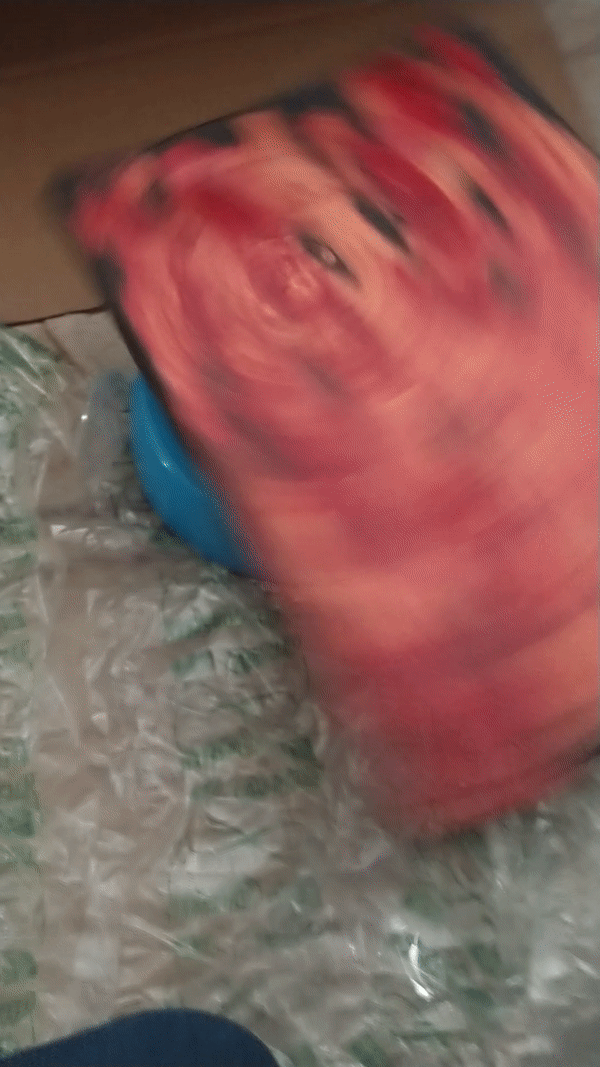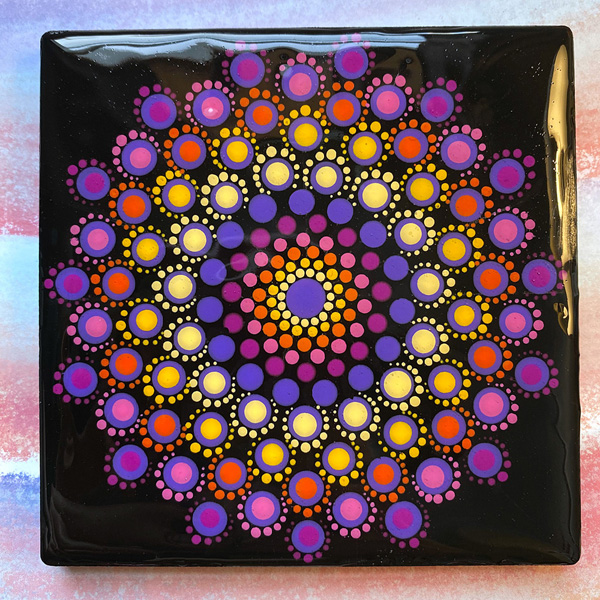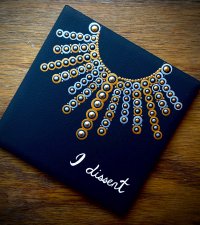Due to growing up in a house with 6 other people, including one who is a decade younger than me, I got used to a lot of noise. It was hard to find quiet moments, so eventually I became good at working with noise. In fact, noise became necessary for me when I work. The quiet is actually a distraction for me. When I moved into a (relatively) quiet dorm for college, I often found myself struggling to make a good atmosphere to study in. Eventually I started blasting music with headphones, or I would sit with friends in the public areas of the school so I could get my work done. It’s the same when I’m making things. If I need to zone out into a project I’ll blast music, but more often I play YouTube videos while I work to keep my mind engaged as my hands are moving. Lately, I’ve been enjoying watching art videos, the more chaotic the better. That is how I recently found myself watching a very fun channel named Chloe Rose Art. One of her longest running series involves her testing art hacks from various places on the internet. Usually I enjoy watching hack test videos just to watch the tester struggle, but one of the hacks she tried stood out to me in particular.
Hack starts at the 4.00 minute mark
In the hack, the artist is supposed to spear a piece of paper on a drill bit, then turn on the drill, all while the drill is dangerously facing up toward the artist. Then, the artist uses a pen to draw on the piece of paper, leaving these cool punk looking spirals. Obviously the hack had issues. Spearing a piece of paper leaves a big raggedy hole in the middle of the piece when it’s removed from the drill, and there were obviously dangerous elements about using a drill face up, let alone in putting your hand so close to a spinning drill bit. But still, something about that cool spiral taunted me. I wanted it. I wanted to use it for backgrounds of paintings. I wanted to play with it. I thought about it, and decided a flat spinning surface would work better (especially for canvases) and be safer overall (questionable in practice). Before I knew it, I was browsing Amazon for photography turntables.
I found myself disappointed. Most of the turntables were more than I wanted to pay to try my silly idea, and they all spun so slowly that it didn’t feel like they would work. Disappointed, I tabled the whole idea.
Then, a week later, I found myself scrolling through Five Below’s website, looking for nothing in particular. I love Five Below, and I use it a lot to find silly things to paint or craft with. It’s the closest thing to an online dollar store that I’ve found since I’ve moved most of my shopping online to avoid the pestilence that has come over the land, and I have an unhealthy love for the dollar store. While I was browsing, I saw it in all of its $5 glory: A children’s pottery wheel.
Here was the solution for all my problems! It moved faster than the piddly turntables, AND it had two speeds. It had a flat surface, and it was FIVE DOLLARS. And it came with free clay and shitty paint. I put it into my cart so fast, and a week later, it was mine. When it arrived, I gleefully went to show it to Anne and tell her my plans. She was less confident.
“That’s going to make a mess”
“Nahhhhh it’ll be fine.”
“You’re going to get paint everywhere”
“I doubt it.”
“Put it in a big box when you use it to be sure.”
“Fiiiiiiine.”
I waited until she was out of the room to try it out.
To be completely honest, I did make a nice little paint proof set up for my spinner. First I spread one of the dog’s blankets on the floor. Then, to avoid having to see the face the dog would make if I took away one of her five blankets, I covered the blankets in some old packing material from the shipment the wheel came in.

Not spoiled at all
Then I set up the box as a backsplash, and threw a few other boxes around me to be thorough. It looked ridiculous, but I figured it would work well enough. I bluetacked the canvas onto a dollar store book box we had lying around to elevate it away from the surface of the wheel, and then bluetacked the whole thing on the wheel. My MacGyver style contraption was complete. All that was left was to turn the whole thing on.

You can just smell the professionalism
With a shuddering demonic whine the pottery wheel spun to life.

It clearly was struggling with the weight of the 11x14 canvas, and refused to spin until I turned the speed up to the second setting. The thing is, the speed setting it located on the bottom of the wheel, and the canvas overhung the wheel by quite a bit, so when I hit the speed slider and increased the speed, the canvas thudded right into my wrist. Luckily the power was low enough that the canvas stopped upon hitting me, and only hit me with the force of a strong tap, but if the motor had had more power, it might have been a different story. I moved my wrist out of the way and the machine started spinning, whipping my canvas around in a way that seemed to put it in danger of flying off at any moment.
I was fucking delighted.
Okay, the pottery wheel obviously has issues. The surface is a little low on the machine, requiring me to use haphazard setups to get my hollow backed canvases to attach to it. And realistically, while it was more safe than using an upright drill, my setup still had some obvious safety issues. My redemption lied in how cheaply made the wheel was, causing it to lack the power necessary to do horrific amounts of damage. But it WORKED. I experimented with different paints and brushes on some of my randomly prepared canvases to see what kind of swirls I could get, my favorites where the small flat brush and the big poofy makeup brush, two very opposite brushes that both gave me the cool chaotic yet controlled kind of feel I was looking for.


And the best part? Not a single drop of paint went flying.
At least, not at first.
In my tests that involved me using the wheel as I had planned to, the paint remained on the canvas. Even the big globs of paint that I put down so that I could smear them around with a palette knife at speed stayed nice and neat.


So, knowing that the paint was staying put, I decided to do some tests to see how wet the paint had to be to splatter off. I grabbed some craft paint, added water, then splatted it down on the canvas with a big brush. This did make a mess, but from what I could tell, the paint wasn’t spattering off with the rotations, it was just spattering all over as I shook the brush. And when I stopped the wheel (with another whack at my wrist) the result was a cool circular splatter that spread out toward the edges of the canvas.

So I turned the wheel back on and poured the watery paint that I had left. Still, barely a splash, though some drops did manage to find their way over the edge of the canvas.

I think I’m perfectly justified in saying “Nyeh Nyeh” to Anne now.
*Note from Anne: She is not! If I hadn’t said something, my living room would look like a crime scene right about now!!!!
So, would I recommend doing what I did and buying a kid’s pottery wheel to strap canvases to it? Not unless you’re a fan of rotary bludgeoning weapons. That said, I had fun, and I’m totally going to keep using this. With some modifications. What I do recommend is looking at items and materials in new ways. You never know when you’ll be able to solve a problem you never even knew you had, and the joy in art comes from making something completely new. Try something new, use things in ways they’re not meant to be used (though please make sure you do it safely), and play around!










































